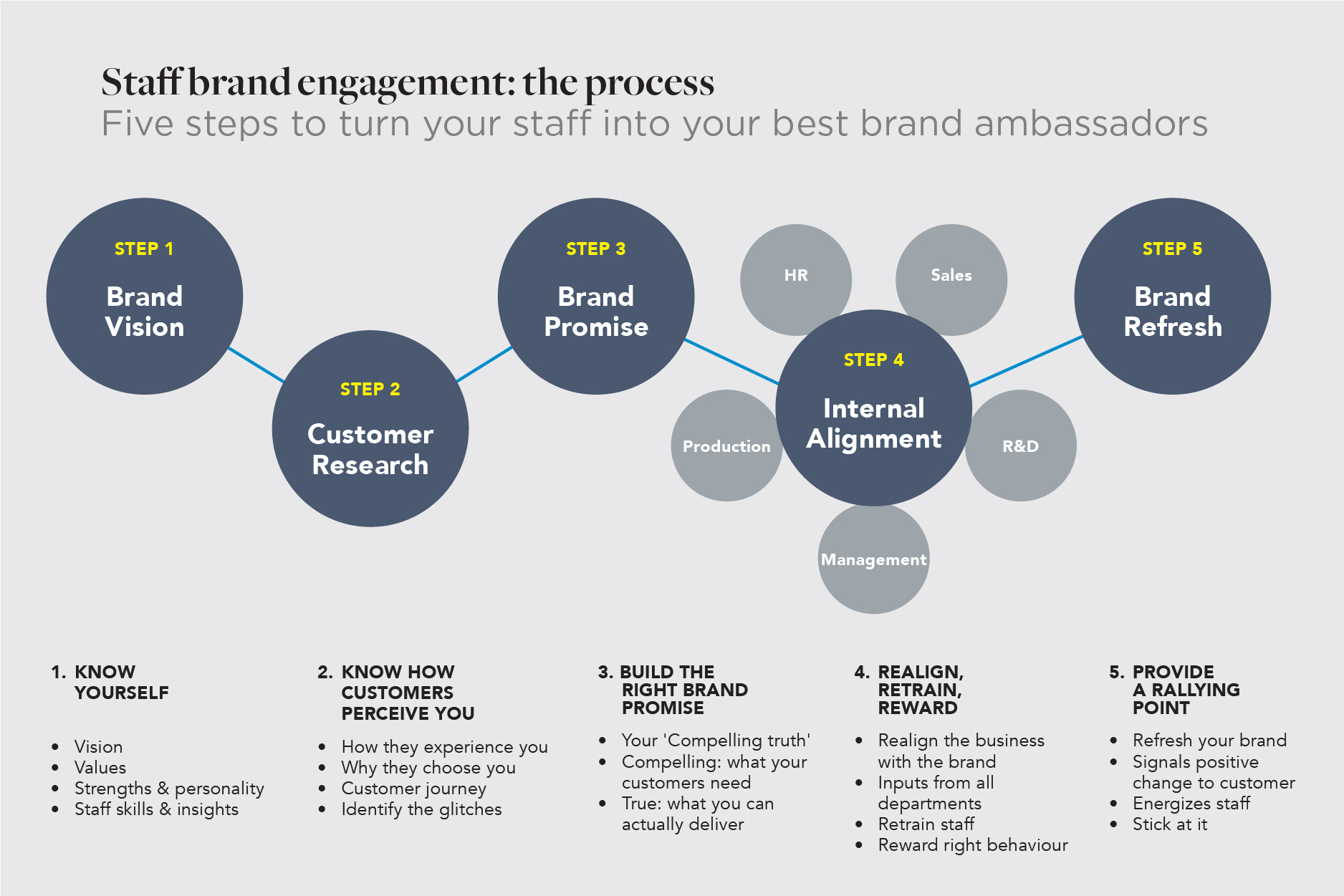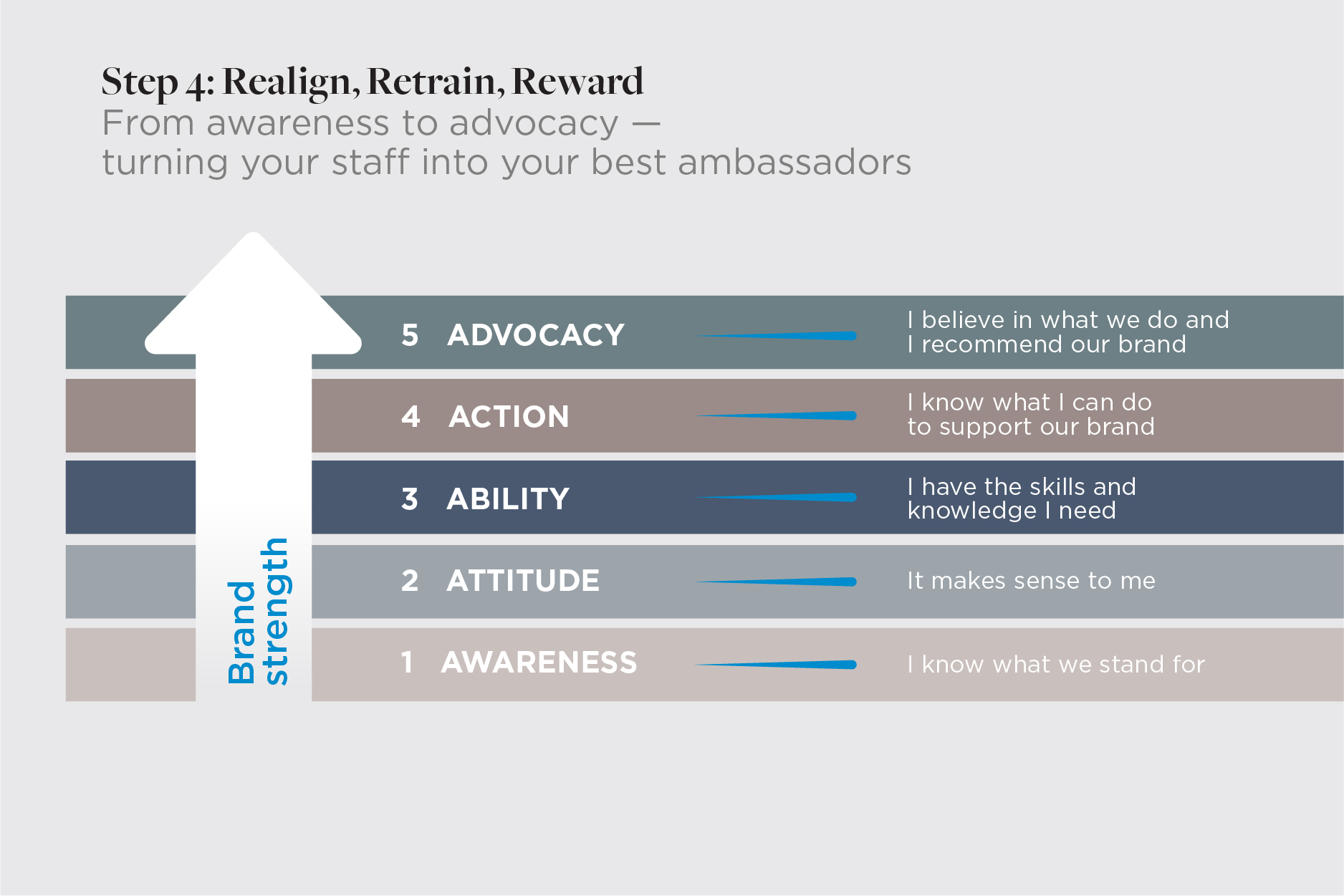Inspiring your people to ‘live the brand’ – Part 2
How to turn staff into your brand’s best ambassadors
As far as customers are concerned, your staff are your brand. How they live it out in their daily interactions with your customers, will make the difference between success and failure. So inspiring them to love the brand and become living incarnations of it is vitally important, although achieving that is far from easy. Here we explain how to do it, in five clear steps.
We’ve all been there, done that, and hated the experience. Microwaving our brains with our phones while we wait endlessly for our banking query to be answered, from a call centre the other side of the world. Waiting for hours by the roadside for our car to be towed, after being told to wait just 30 minutes. Fobbed off with feeble excuses by ‘customer care’ staff, when we complain about a faulty product we’ve paid a lot for. Turned away with a valid air ticket by check-in staff, because the flight is overbooked or cancelled, and not being properly compensated afterwards.

It’s been said that a brand is only as strong as its worst experience, and usually those bad experiences come down to staff interactions like these. The irony is, in all the above scenarios the company concerned probably has standard procedures to handle them correctly, written in a manual somewhere. But they fall apart because of the people who have to deliver them – the company’s employees. Because they haven’t been properly trained, or bought into the company’s vision, or care about their jobs, or lose their tempers, or get tired and stressed, or had a bad day. But above all… maybe it’s because they’re not excited enough about the company’s brand to want to live it out in the first place?
That’s the holy grail of branding, and business success – when all your staff are aligned with your brand, and become its best and most enthusiastic ambassadors. But how do you achieve this? What if you’re a family owned SME, and don’t have the resources of a Singapore Airlines or a Unilever or a DBS Bank to throw at this? How can you turn your employees into personal manifestations of your brand?
Well it IS challenging, and painstaking, but we believe that it can be achieved by taking the following five steps:
Step 1. Know yourself
Whatever else a brand is, it has to ring true – it needs to be authentic. So the first stage is a process of self-discovery, in which you make a frank assessment of your brand, warts and all. Because sometimes what we think of ourselves, our strengths and weaknesses, is way out of step with reality. Organisations who view themselves through rose-tinted spectacles risk making promises to customers they can’t keep. This process will mean defining or agreeing what your vision and aspirations are, as well as your values and culture. What are your key strengths, or attributes? What do you stand for, and won’t stand for? How would you describe your personality?
This first part of the process should come from the leadership – they need to create a unifying vision and clearly expressed goals and values. But the leadership also need to walk the talk. If management behaviour is not consistent with the company’s stated vision and values, then the staff can’t be expected to embody it either. Living out the brand needs to begin with the leadership.
But it also needs to come from the ground up. Knowing yourself is also about understanding what your employees think of your brand, and finding out what their aspirations are, to see how these align with yours. Delivering the right brand experience depends increasingly on a company’s ability to harness the aspirations and ideas of its employees. It’s also about uncovering what their unique strengths and attributes are. If one of the key manifestations of your brand is your people, then you need to know what they bring to the party, and how that makes your brand special. Their energy, insights and initiatives are integral to the brand proposition itself, and not only in engaging them to be your best brand ambassadors.

Step 2. Know how customers perceive you
The second stage in the process is about understanding how your customers experience your brand, what they think of you, and why they choose you over your competitors. What are they looking for that you claim to supply, and how do you meet (or fail to meet) their needs? You will almost certainly be surprised, as their assessment of your strengths and weaknesses, and what they value most about you, may be completely different from yours. But the aim of this stage is to find out what resonates with your customers and what doesn’t, and build a marketplace proposition around what you can genuinely deliver.
One way to do this is to conduct some independent research on how customers experience your brand and perceive it in terms of image. Another way is to undertake what is called the ‘customer journey’. In other words, put yourself in the shoes of your customer and walk through all the details that form a journey through your organisation, and see how those experiences align with your brand.
Typically the customer journey will start with the experience of your website, accompanied by reviews of your product or service on internet forums or social media. It might follow with a call to your company, or an email, and includes how your staff respond to that enquiry. Then if they visit your premises, it will embrace the way they are served and assisted by the staff, either in exercising hospitality, or giving advice, or presenting or selling your products, or providing after sales service. And when your product or service hits a snag, it will conclude with how your staff deal with glitches and complaints, either remotely or in person.
How your staff handle this last scenario is probably the most crucial in either making or breaking your brand. But every experience can do that, and it isn’t hard to see why – the common link is your staff – and how they manage these situations.
Taken together with all the other customer inputs, a true sense of how your brand lives in its own environment and what it stands for in the customer’s mind will emerge. At the same time, it will highlight all those areas where the experience of your brand falls short, and what needs to be fixed, particularly in the way staff live it and deliver it.
Step 3. Build the right brand promise
Once you’ve decided what your vision and values are, and agreed on your core focus, and factored in your organisation’s capabilities, as well as your staff strengths and your customer’s preferences… then you need to develop a brand promise that truly aligns all of the above into one authentic brand promise. Because only when you’ve decided on your brand promise – in other words, what your staff can authentically deliver – can you then focus on how best to express that promise in the way the business is organized.
We call the brand promise your compelling truth. Because it must be both ‘compelling’ to the target audience, and equally ‘true’ – in other words, it must be something that your staff can deliver day in, day out, for every customer, whatever the weather, without reservation. Otherwise, it’s no promise at all.

Step 4. Realign, retrain, reward
The next stage in the process is to organize your operation around your brand. You need to redesign and realign all your procedures so that they fulfil the brand promise and deliver the right experience. This means getting all the different parts of your organization – management, sales, production, service, HR, accounts and administration – to step outside their silos and talk to each other about how to achieve that. Because every department and every staff member are crucial to the brand experience, not just management and sales.
Once that is done, it involves formal training of your staff in the vision, the values and the right experience of your brand, so they know how to live it out. Training which answers the question “what can I do to fulfil our brand promise, on a wet Monday morning?’ And it isn’t easy. It involves changing priorities and hard-wired behaviours, motivating staff not only to buy into changes but also to propose and make the changes themselves. People must want to do it – they must want to behave in a way that supports the objectives of the company they work for.
How do you achieve that? First of all, the age of purely top-down management is over. ‘Need to know’ management cultures breed ‘don’t need to bother’ staff. People work much better if they know why a company exists, the challenges it faces, and what role they can play in achieving that bigger purpose. So nowadays encouraging bottom-up feedback and ideas for process and service improvements is not only good, it’s VITAL. Empowering staff to use their own expertise to solve problems and come up with new ideas, and giving them the resources to do that, is the best way to harness their initiative and secure their sense of ownership of your brand.
Then they need to be rewarded in the right way. If performance appraisal, remuneration policies, and promotion opportunities are not aligned to reinforce the brand behaviours required, conflicting messages will be sent out about which behaviours are really important.
Step 5. Provide a rallying point
Once your operation has been reorganized and staff trained to deliver your brand promise, the final step is to make some sort of visible sign to your customers and your staff that something has changed. One of the best ways of achieving this is to refresh the visible expression of your brand – your logo and brand identity. Particularly if the internal reorganization resulted in a new focus, or new services. In this way, customers will be made to look at you with fresh eyes.
But it isn’t just a signal of change for customers, it’s also a rallying point for staff. You need to get the whole company feeling that they’re involved in the creation of something new. Because for staff at every level to embrace their role in fulfilling the brand promise, they need to feel excited that they have a new future, a future they helped to shape. In this way, you encourage the whole organisation to ‘live’ the brand.
At the end of the day, when it comes to customers, while the logo refresh is an important symbol, the main point is about how staff deliver the brand, not how pretty the logo looks. Because in branding, actions speak louder than words.
Finally, while the five steps we’ve outlined are effective, this whole exercise requires tenacity. Once you’ve agreed what your brand stands for, and decided how you’re going to deliver it, you really need to stick at it. Because changing ingrained habits and behaviors is hard, and while you may start out thinking this is a journey to a destination, eventually you realise this is an ongoing task that is never ‘done’. Aligning all the moving parts of your organization to deliver your brand promise is a constant challenge, that requires constant effort.
If anything we’ve said above resonates with you, and you’d like to talk to us about how we can help you to inspire your staff to live out your brand, just drop us a line at sales@equus-design.com.





RELATED ARTICLES